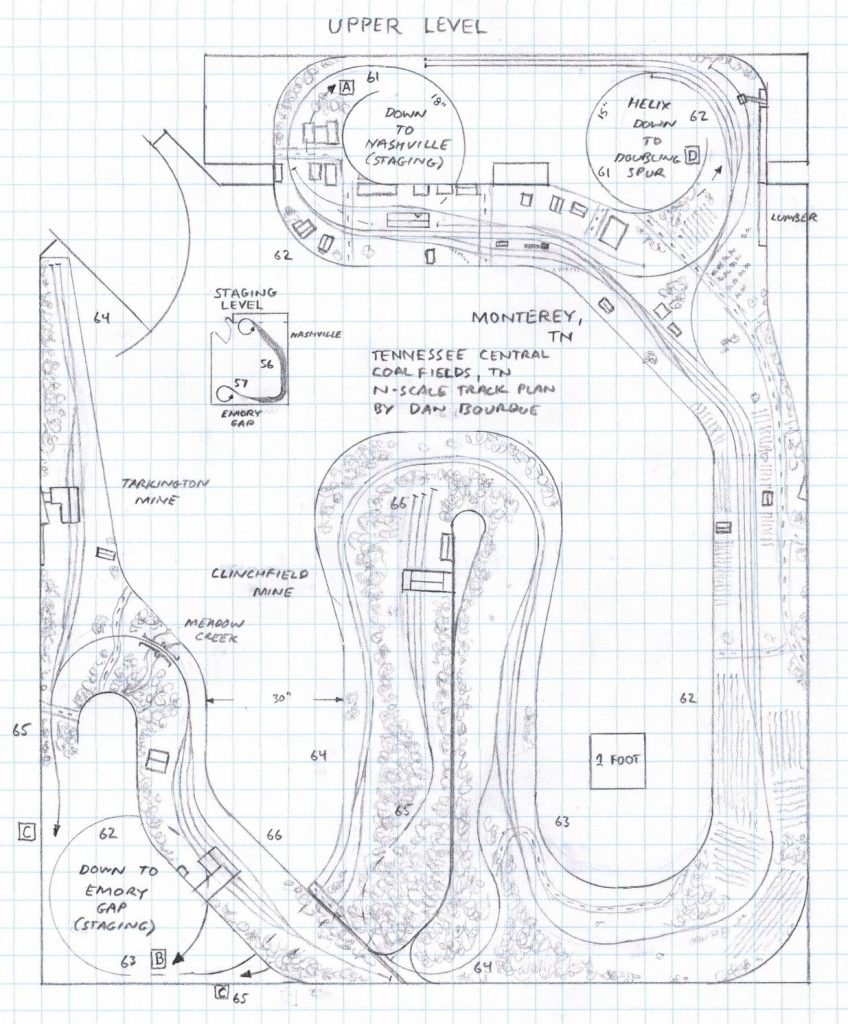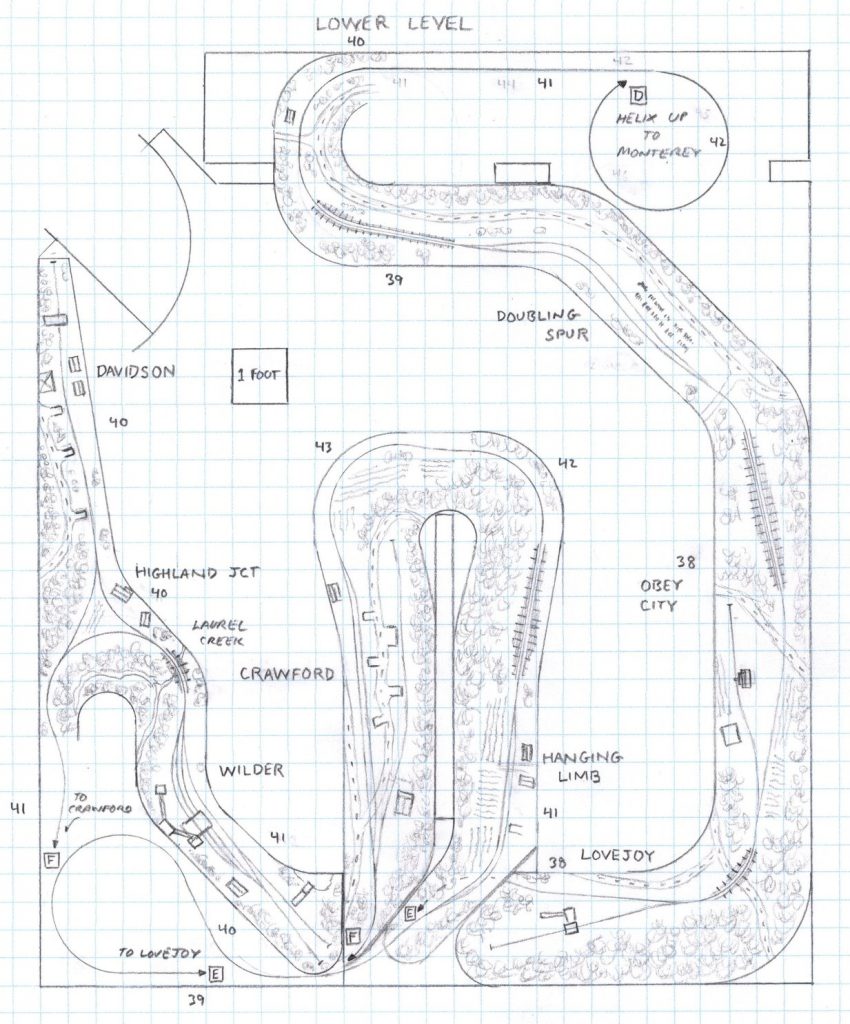- Size: 14′ x 17′
- Scale: N
- Minimum Radius: 15″ (18″ on mainline)
- Minimum Aisle Width: 30″
- Designed by Dan Bourque
This is the first significant “Tennessee Central” content of any kind on Appalachian Railroad Modeling, but I doubt it will be the last. The aptly named Tennessee Central (TC for short) reached from southwestern Kentucky through Nashville to east Tennessee, and coal was one of the major commodities generated on the line. In the diesel era, the TC hauled short trains including lots of coal over lots of wooden trestles with a range of Alco locomotives in an attractive maroon and cream (later black and white) paint scheme–what’s not to love? This layout captures the heart of the TC’s coal field operations – the small town of Monterey, TN – in the mid 1950s, coal’s heyday on the TC. The TC’s primary artery for coal was the 20-mile-long Crawford Branch which left Monterey via a wye off the mainline. A few more moderate-sized coal tipples lay just east of Monterey, served by spurs off the main. In addition to all the coal, Monterey lie on the TC’s main and saw numerous through freights per day, and it was a crew change point. All this adds up to a great area to model!
The Layout
This layout is designed for a good-sized bedroom. I specifically chose N-scale for this layout because it allows the spread-out nature of this area to be modeled well, and it allows the TC’s signature wood trestles to be modeled close to scale. Additionally, the vast majority of coal loaders in this area appear to have been served with a single spur making switching operations in N-scale a little less tedious. I chose to focus the layout on the coal operations which means 1) the town of Monterey, 2) the Crawford Branch and 3) a few of the nearby tipples off the main. Consequently, only about 3 prototype miles of mainline are modeled. One of the decisions I made early on with this double-deck plan was to model the mainline on the upper deck and the branch on the lower. While this meant providing top-level staging (never ideal), it did two things for the layout. First, the TC hauled coal “up” to the main necessitating the doubling of heavy trains, and I wanted to capture this. Secondly, it allowed the incorporation of tall trestles on the lower deck without the constraint of a staging yard underneath the lower deck.
The upper deck is focused on Monterey. The large wye in the center of town is fully represented along with a slightly truncated yard and servicing facilities. The TC had what they called the “old yard” on the Crawford Branch leg of the wye–I chose to compromise here by not fully modeling this leg of the wye in favor of the main, but two of the yard’s three double-ended tracks are represented by long stub tracks to allow the stashing of extra coal hoppers when needed. The large lumber mill on this leg of the wye was served with a single spur, and while parts of the spur are beyond reach without ducking under, the switch is within easy reach which should allow switching access to the whole spur through “delaying” couplers. Moving RR east from Monterey, the line runs through alternating sections of woods and farmland until it reaches an unnamed siding where two coal branches left the main. The first is a short looping spur to the Clinchfield Mine–the actual track looped and nearly doubled back on itself, but I did have to compromise here with two sets of rails being in the same scene–the alternative was to just make this branch a staging track… I’d rather have another tipple! Finishing out the upper level is the branch to Tarkington Mine which split near the end to serve a “modern” mine built circa 1950 for which I have no name.
The staging level is directly under the upper level. The main descends in single-turn helixes at both ends, and a long, double-ended staging yard would sit under Monterey. I envision that these staging tracks would be mostly hidden with access portals through the fascia at strategic points. Access would be aided by removable fascia along this aisle.
The lower level represents as much of the 20-mile Crawford Branch as I could squeeze in, and it would make a pretty nice layout by itself if double-deck is not your thing. I cut the branch into three segments which offer the most operating potential. In doing so, I skipped over a couple of trestles and at least two small tipples, but I believe the uncompressed result with hidden runs lengthening the space between scenes is worth the compromise. The branch had a seesaw profile, the direction of grades is mostly prototypical with Crawford being the high spot in the middle of the branch. In aerial photos circa 1955, most of the loaders on this branch appear to be nothing more than docks for dump trucks and bulldozers, so that’s why you see so many in the plan (including five docks in Crawford alone). I don’t have track charts for this branch, so I did the best I could with aerial photos and topos. One curiosity is the branch to Davidson near the end of the line–I can spot four docks and a small tipple, and all appear to be operating off the same track. It makes for some interesting switching, but it can definitely be done. I also included as many tipples as I could fit which includes three long, straight tipples and two shorter tipples that I had to curve to fit into the space, but there are enough to give the impression that long tipples were an important part of this line. In all, I was able to include 17 coal loaders on the track plan along with one large lumber industry. Additionally, aerial photos show the TC loading something stacked in rows into boxcars at Doubling Siding… lumber? Tobacco?
For control, this layout lends itself well to DCC and walk-around throttles. Following trains is pretty straightforward as trains entering hidden trackage emerge nearby a minute or two later. This means wired throttles would not be a major liability, though with the ease of adding smartphone throttles these days, that’s not a big factor. Because realistic sound is difficult to achieve in an N-scale locomotive, this layout would be a great candidate for something like Soundtraxx’s Surroundtraxx system which uses DCC blocks and speakers throughout the layout room to “follow” the train with sound. It would not be tough to cover this layout well with 5 speaker zones and a subwoofer.
Operations
Physical space for operators will likely limit operations to 2-4 people, but it would definitely keep those operators busy for a few hours! The “big jobs” on the layout would be Crawford Branch Mine Runs, probably 2 per day to work the 14 modeled coal loaders. Crews would start by picking up their locomotives (probably a pair of RS3s) and cab next to the Monterey station and making up their train of empties from strings left in the yard. Heading down the branch, a crew would work 5-8 loaders, perhaps the first mine run working Davidson and Wilder and the second mine run working Doubling Spur to Crawford. Speaking of Doubling Spur, the major grade between here and Monterey meant most loaded trains had to double their train on the hill by leaving half in the siding and returning for it after delivering the first cut to Monterey. This would add a lot of extra time to the mine run jobs, though the fact most of it is in a helix means you might choose to skip this part.
A third mine run could work the tipples on the upper deck making one or two runs as needed. These three trains would be enough by themselves, but there’s also a mainline. The TC was never terribly busy, but several trains might pass through Monterey daily. After 1954, coal primarily went east to Emory Gap, TN for use at the new Kingston Steam Plant, so at least one turn out of Emory Gap to deliver empties and pick up loads from Monterey would be in order. Additionally, the TC ran short passenger trains 1 and 2 from Nashville to Harriman (just past Emory Gap) until July-1955. Other mixed freights, to include some meager TOFC service, would transit this line as well with power being mostly 2-3 RS3s with a few FAs in the mix. The double-ended nature of the staging makes the recycling of trains possible during an ops session to run as many mainline trains as you like. Rather than having a dispatcher, a single operator could run the main following a train schedule, occasionally using the tracks at Monterey or the siding east of Monterey for a meet to keep things interesting.
For variety, the traffic level on the TC varied dramatically over the years with 1956 being highest traffic level the railroad ever achieved, moving 3.5 million tons of freight. Moving to either side would mean less traffic. Shifting the era earlier would allow some steam alongside the diesels (1952 was the last use of steamers on the TC). Shifting to a later era would introduce new Alcos including RS36s and C420s, but many of the coal operators would have shut down by the early 1960s as the Kingston plant began using more L&N coal and the local seams ran out. By the time the TC ceased operations in August 1968, nearly all the mines were already closed.
Things I Like About This Plan
- Relatively uncompressed
- Generous mainline radius
- Good ratio of operations to scenery
- Lots of cool, long trestles
- Variety of traffic
- Continuous running option via staging
Things I Don’t Like About This Plan
- Staging in the middle
- Some tough-to-access tracks
- Some awkward track transitions through backdrops
Related Products:






Dan, the Monterey Railroad Museum should possibly have the info missing on track charts and mine names from this area. They have a great display for the coal mining in the region, you may want to check it out sometime.